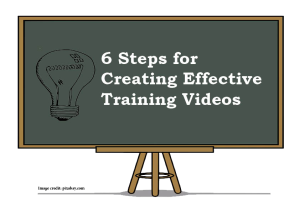6 Steps for Creating Effective Training Videos
Whether you’re hiring a media production company or producing a training video on your own, it is important to follow some basic steps, which will help you produce an effective, easy-to-follow and useful video.
1. Start with a clear objective for your video.
Before you share your knowledge and advice on how to complete certain tasks, you need to introduce yourself, your role within the company and the objectives of your video.
Who are you addressing and what are you aiming to achieve? Is it a crash-course, a follow 5-easy-steps guide or a series of online workshops where your audience can find out more about how to use your latest products and services?
Whatever your purpose, make sure you explicitly explain what you will be demonstrating and how. A structured video that flows easily from one section to another, will hold your viewers’ attention and facilitate their learning.
2. Structure your video
Make sure your video has a clear concept and a coherent presentation style. Develop a detailed ‘lesson plan’ and decide what areas you will be covering. Whether you decide to hire a professional actor or use one of your employees, make sure that the tone of their delivery remains constant throughout the video. Instead of producing an all-inclusive video that fails to go into detail, it might be better to break down your syllabus and produce several shorter videos.
3. Keep it short and simple
Very few will watch a 50-minute video no matter how well produced or interesting it is. Do not attempt to cram too much information in a single video or try covering all sections in explicit detail, as that will decrease your video’s effectiveness.
Research has shown that adult attention spans vary between as little as 8 seconds and as much as 20 minutes. Hence you need to make sure that your training video will acquire the right length either as an individual short training video or a segment of a larger series.
When producing a training video it is only natural to assume that your viewers acquire a basic understanding of what you will be demonstrating. Try to establish the level of your audience without assuming they know more than they actually do or without producing a very elementary basic video that is repetitive.
4. Use a Script
Using a script or some bullet points, will help you maintain a paced delivery without sounding as if you are reading a script from a teleprompter or have memorised a bunch of information. Presenting yourself in a confident and comfortable way will enhance your image as an informed professional who is sharing his expertise.
Establish the tone and style of your video; whether you’re aiming to come across as a serious expert or a friendly instructor, you need to maintain the same style throughout the video. Always make sure your video coincides with the image of your company and its brand identity.
A good training video is one that acquires an informative, professional but also conversational tone. Through your video you are aiming to help and offer instructions, hence you need to seem knowledgeable, but most importantly accessible so people will feel comfortable watching you.
5. Be positive
A training video should be understood as a tool for learning, not an opportunity to address common mistakes your employers make. Try to break down your video on how they can anticipate problems and come up with solutions, instead of going through the “most common” issues with the latest company product.
6. Educate & Entertain
Keep your videos focused and easy to watch. Including info graphics and quizzes or tests, will transform ‘another obligatory training video’ to a more enjoyable learning experience. Will it be a do-it-yourself activity or will it involve teamwork? Without diminishing your video’s instructive tone, think of ways to engage your audience and make it more stimulating for them. Try incorporating social media channels, encouraging your users to share their experiences and questions- this way they will get more involved with the learning process and build on their team working skills too!
If you decide to produce your training video on your own, it is essential that you use a good video camera that will offer you clear, high-resolution footage, a tripod to avoid shaky shots and an external microphone. Using the camera’s built-in microphone could result in poor audio and that will diminish the quality of your video.
On the other hand, contracting a video production company may raise your budget, but will also ensure that your videos are of top quality. All that’s left then is for you to share your knowledge and help your customers enjoy the most of your services and products.
We work with all our clients to develop innovative and interesting ways of delivering their story. Contact us at info@novapictures.co.uk or for more information visit novapictures.co.uk

Reblogged this on New Affiliate Marketing.